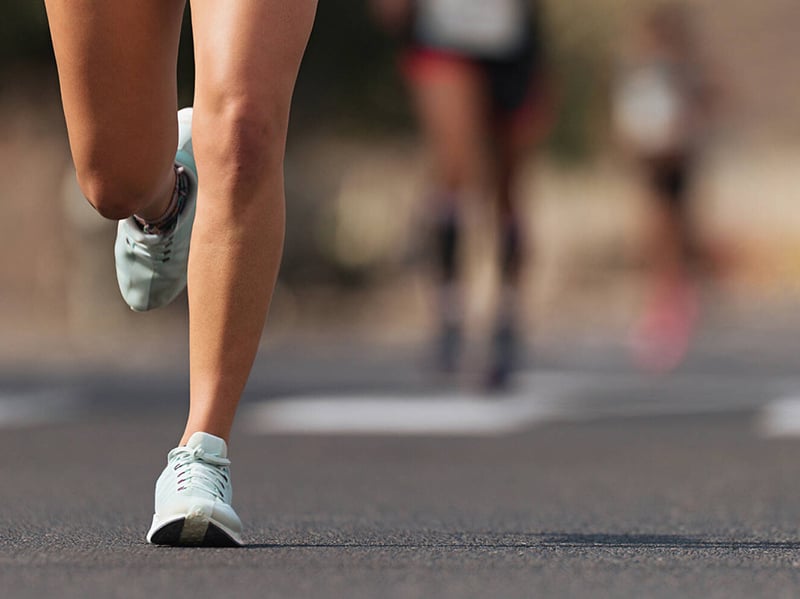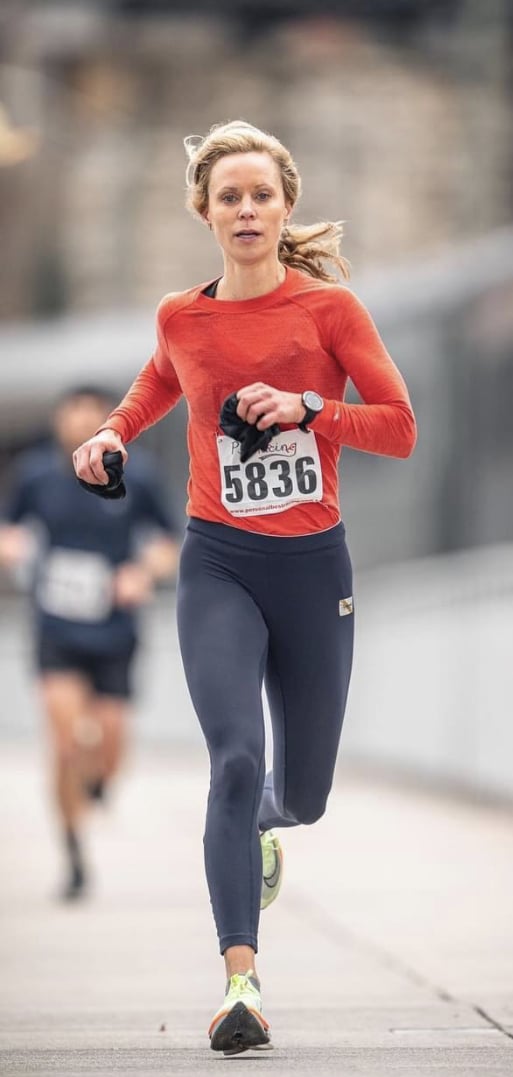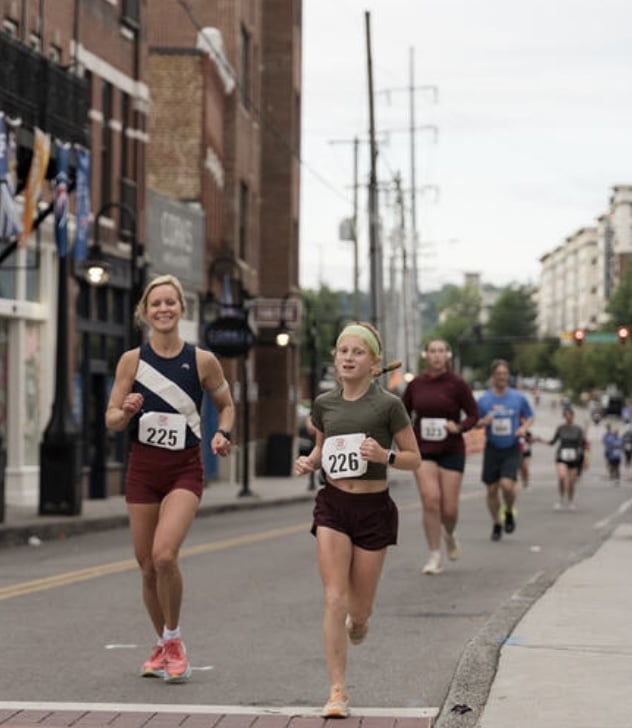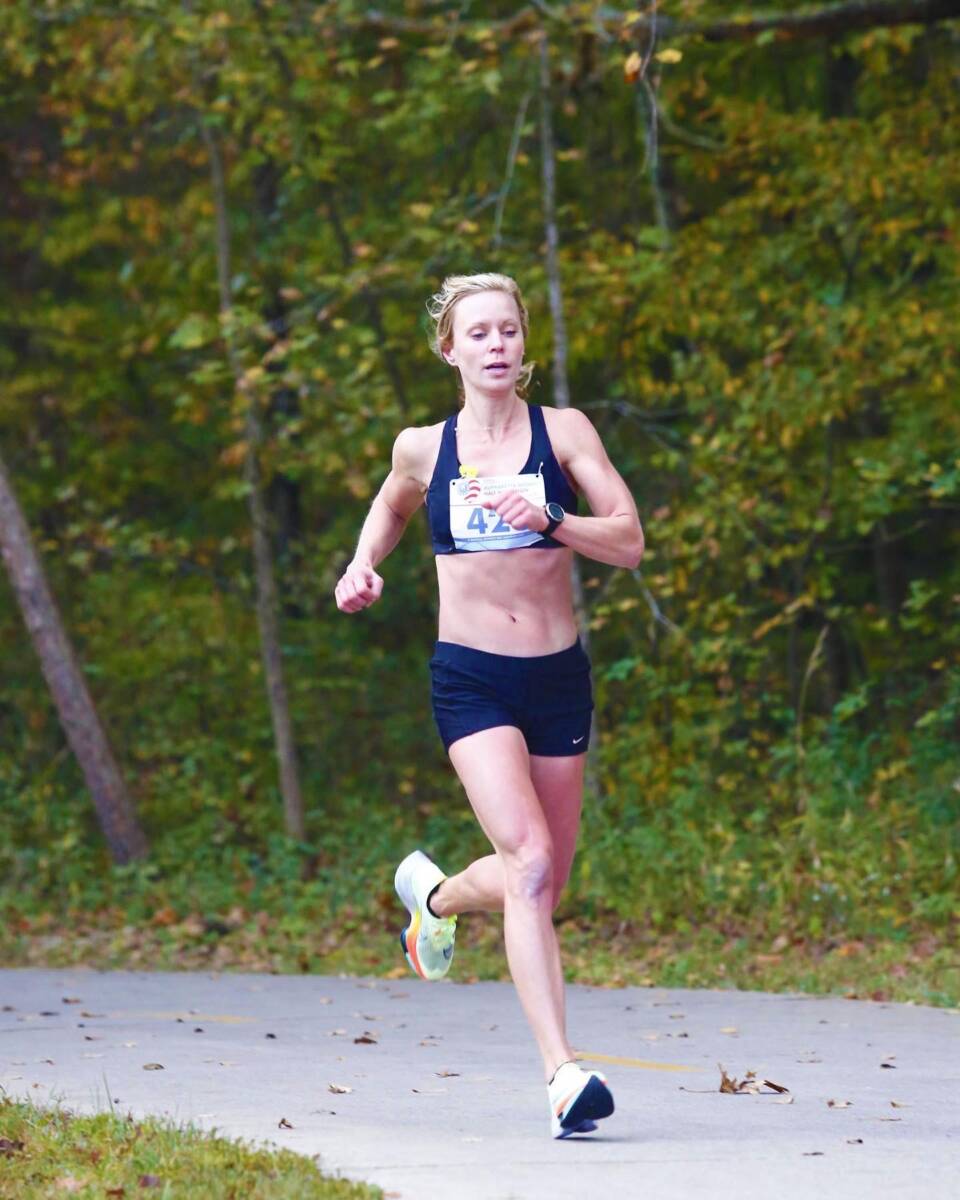My Experience Running the CIM Marathon: A Full Review
Well, I did it. I ran one of the best, fastest, most organized marathons in the U.S.—the CIM Marathon (aka the California International Marathon). I wanted to offer an honest CIM marathon review.
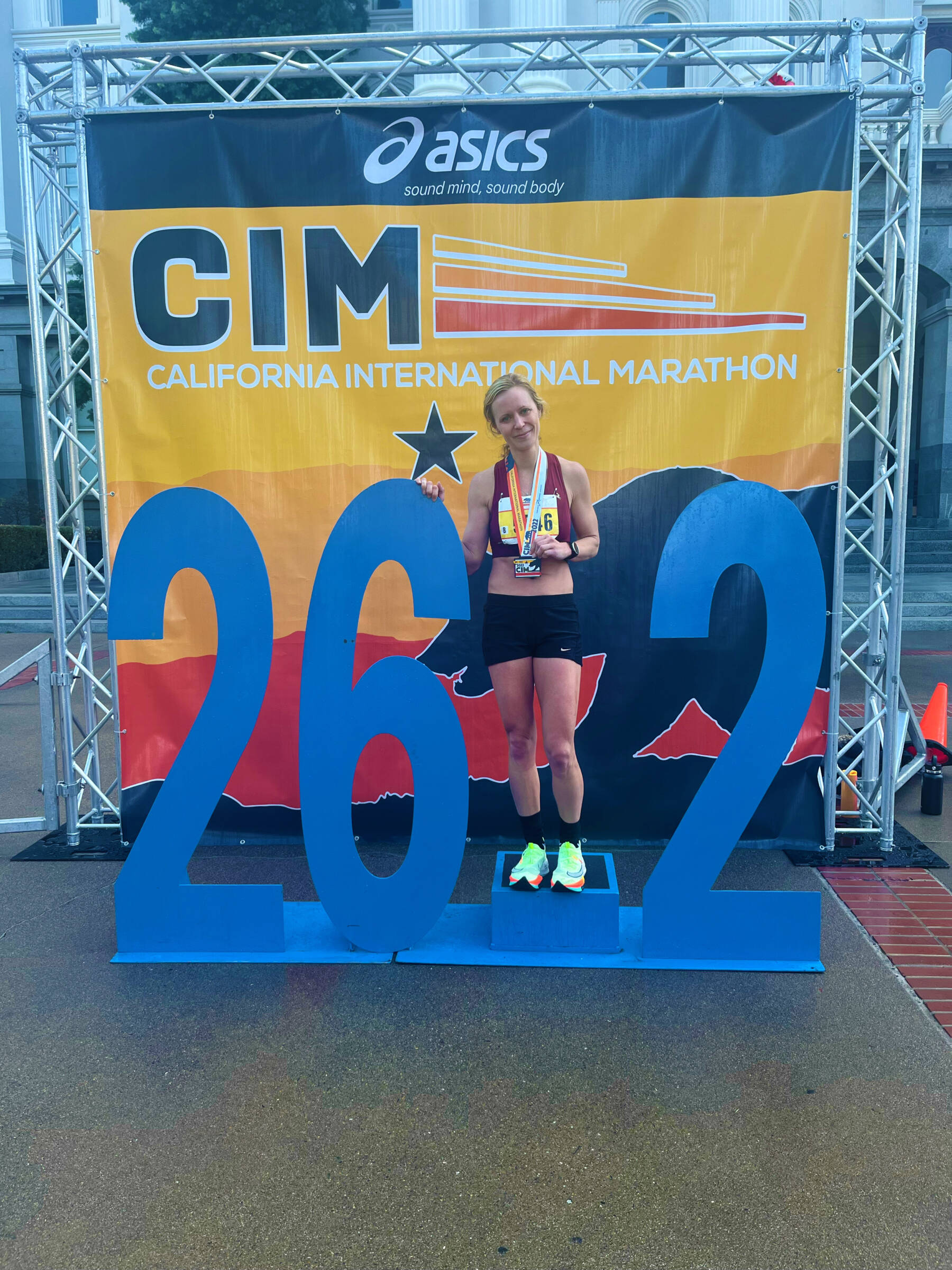
After being injured for 2.5 years and running my last marathon more than three years ago with a torn hamstring, I wanted a good experience. I wasn’t going to mess around with a sub-par marathon. I heard only good things about CIM (which google calls the CIM Marathon to distinguish it from an investment company), so as soon as I was given the green light to run again, I signed up.
Unfortunately, I did not have a good race at the CIM marathon—but it was not due to any factors of the marathon itself. My legs just didn’t have a good day. (Read my Instagram post about it here).
My training had me fit to run a sub-2:50 that day. But my legs locked up at mile 16 and I ran a 2:58. While I was borderline devastated (let’s have some perspective here), I am also happy to be running again after being injured for almost three years.
There are always silver linings in a marathon and lessons to be learned.
Table of contents
- What is the CIM race?
- What makes the CIM marathon a good race?
- Is CIM marathon downhill?
- When is the CIM Marathon?
- What time does the CIM Marathon start?
- Is the CIM marathon a Boston qualifier?
- How do I get CIM marathon results?
- Does the CIM marathon sell out?
- Do you have to qualify for CIM?
- CIM Marathon Course & Logistics Details
- Key CIM race strategy details:
CIM is a fast course if you run smart.
Even though I did not have a good day—so many people did. And that’s because the CIM marathon is one of the best and fastest marathons in the U.S. you can run. And I want to set YOU up for success on race day. Why?
Because even though the CIM marathon is an amazing race, there is a lot of room for error if you plan to just show up and run. It is a course you need to race smart. Calculated. This is not a race to get into the “flow” and run. Your head must stay in the game. Don’t get carried away.
Plus, with more than 9,000 runners showing up on race day, you need to know the logistics well ahead of time.
What is the CIM race?
The CIM race is the California International Marathon which is a net downhill point-to-point 26-mile, 385-yard marathon course running from Folsom Dam to the State Capitol in Sacramento, California.
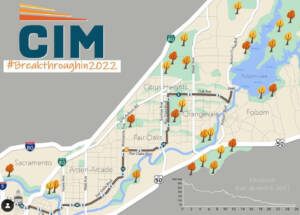
What makes the CIM marathon a good race?
The CIM marathon should be at the top of the list for any runner wanting to set a personal record (PR) or qualify for the Boston Marathon or Olympic Trials.
The CIM marathon has everything a runner (and spectator) could want on race day:
- a point-to-point course with minimal turns and potholes
- incredible volunteer and crowd support throughout the entire 26.2 miles. Indeed, there are more than 2,000 volunteers for about 10,000 runners.
- a net downhill course of 366 feet with gently rolling hills to give muscle groups a break.
- Packs of runners throughout so you won’t have to run alone
- a well-organized race knowing the needs of runners and spectators
- dependably mild weather optimal for running performance
Is CIM marathon downhill?
Yes, the CIM has a gently rolling, point-to-point, net downhill marathon course of 366 feet with few turns and potholes. The CIM start is at a 366 feet elevation and its finish is at a 26 feet. The last 5 miles are downhill to pancake flat.
When is the CIM Marathon?
CIM is usually the first Sunday after Thanksgiving week. This year, CIM was held on Sunday, December 4, 2022.
What time does the CIM Marathon start?
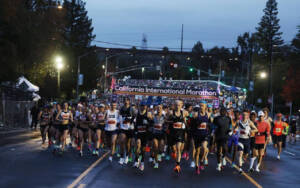
CIM has an early start time of 7 a.m. Pacific. However, for east coasters such as myself, this start time will feel late.
Is the CIM marathon a Boston qualifier?
Yes, the CIM marathon is a Boston qualifier as well as an Olympic Trials qualifying marathon course. Indeed, a third of runners who run the CIM marathon course qualify for the Boston Marathon.
CIM boasts the most Boston qualifiers than any marathon in the U.S. and the fastest course in the Western U.S.
This year, more than EIGHTY men and women combined qualified for the Olympic Trials marathon despite the USATF announcing tougher standards for 2024.
CIM is the go-to race for PRs and time-based barrier busters like Lift. Run. Perform.’s breaking 3 project.
How do I get CIM marathon results?
The week of the marathon, CIM will email participants, post on its site, and share on its social accounts the tracking app to track your marathoner.
The final results of the CIM marathon will be posted on the CIM website the day of the race.
Does the CIM marathon sell out?
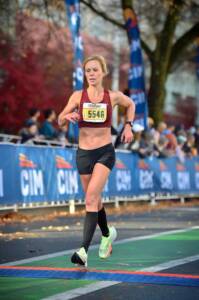
Word of the CIM marathon has spread and so it does sell out. This year, the CIM marathon sold out months before race day.
If you are thinking of running the fast CIM marathon course, I recommend signing up sooner rather than later. You can always transfer your number.
Do you have to qualify for CIM?
No, you do not have to qualify for the CIM marathon.
CIM Marathon Course & Logistics Details
Lodging:
With a point-to-point course, you need to decide if you want to stay close to the start in Folsom or Point West (a bit further from the start), or the finish in Sacramento. There are transportation options for all.
I opted to stay near the start in Folsom where there are a cluster of hotels near the CIM bus pick-up location near Whole Foods plus a ton of shops and restaurants for carb-loading.
We stayed at the Hampton Inn and it could not have been more convenient and the hotel was ready for an influx of runners. They had coffee and breakfast ready by 4:45 a.m. race day morning and an automatic late check-out. However, the hotel walls were thin so we bought earplugs!
CIM also has a partner hotel with direct transportation options. Check the California International Marathon lodging options here.
Transportation:
Important: You CANNOT be dropped at the start line. You will have to get up early and take the bus. Or sleep in a little and be dropped at one of the shuttle drop sites about two miles from the start line.
- If you stay near the finish, then you need to plan for an earlier morning by thirty minutes. The busses to the start leave promptly at 5 a.m.
- If you decide to stay near the start, then you will still need to plan to get to the buses by 5:30 a.m. or to the roving shuttles at 6 a.m.
I decided to take the bus because I knew it would get me to the race in time to hop in the port-a-potty line two times and do a warm-up. Less stress is best! So do not press yourself for time. You can also stay on the bus to keep warm.
If you do not have a ride after the race, you can take the CIM shuttles back to your hotel.
Get CIM transportation details here.
Start line:
The CIM marathon starts at 7 a.m. Pacific Time.
CIM boasts more port-a-potties per runner than any other race: one portable potty per every thirty runners. However, the potty line still took more than 10-15 minutes to get through. So, save time for that.
There are not a lot of places to “go” outside if needed. I did find a parking lot about 100 yards past the start where I was able to duck behind a van and go before lining up. Many other runners were doing the same.
My advice is to stay on the warm bus and then get to the port-a-potty around 6 a.m. Warm-up. Then get in line one more time before doing striders and shedding your clothes.
There is an ample amount of signage and volunteers telling you where to go. There are also drop boxes for your clothes that are donated to the homeless.
Note: There is no drop-bag site at the start. If you want a drop bag, you must do it at the expo or bright and early Sunday morning (by 4:45 a.m.) at the finish in Sacramento.
The start is self-seeded so be sure to give yourself 5-10 minutes to slip into the right start spot.
CIM Marathon Weather:
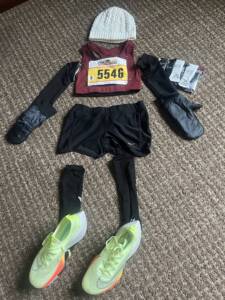
The weather for the California International Marathon rarely holds surprises for abnormally cold or hot temperatures. It is usually mild in the mid-40s or 50s. However, it is often drizzly or rainy on race day. So, plan to dress to stay dry ahead of the race with a poncho and throwaway sweats.
And factor in running in humidity which many runners from the Western U.S. are not quite acclimated to.
CIM Course Review:
While CIM is no doubt one of the fastest marathon courses you can run with a big chance of getting that elusive negative split. It’s also a marathon course that can punish those who are overly aggressive on the front end.
You want to run conservatively through mile 16. You don’t want to charge the uphills or fly down the downhills.
There is no zoning out. You must stay mentally engaged to make sure you’re on pace and your lungs do not get ahead of your legs.
There are four short yet perceptible hills on the course, at .7 miles, 8, 10.4, and 21. I live in a hilly area and barely noticed the hills—mostly just with a pace that would slow or quicken five to ten seconds.
CIM takes 1 and gives 2.
Whatever CIM takes in elevation, it gives you back twofold. You are always rewarded with a nice downhill after any uphill.
There are four spots with noticeable turns—around 11, 13, mile 22 leading into downtown and into the finish. However, it is easy to see them coming, follow the runners and run the tangents.
You will never be alone on this course. There are crowds, volunteers, and runners throughout the length of the course. There are DJs, bands, cowbells, barking dogs, and clucking chickens.
And there are trees. Beautiful trees. I have never been to a place with such beautiful trees. There are towering palms, luscious pines, and statuesque cedars. In December, many of the trees are still hanging onto their late fall color. When all else fails, just admire the trees.
Once you cross over the J Street bridge, your final hill, you are rewarded with a pancake flat runway to the finish. Just over four miles running through city streets, past old majestic mansions, and alongside rows of palms to the double-sided finish with rows of spectators cheering you on.
There is little to improve on the CIM marathon course.
Key CIM race strategy details:
So how should you run the California International Marathon? I did my research watching the CIM virtual course preview on the Neurun app, talking to other CIM runners, reading elite runner Peter Bromka’s course review, and of course, running it myself.
Here are some CIM race strategy tips:
You will basically want to oscillate every 3 miles between 5 seconds slower than race pace and 5 seconds faster than race pace. The goal of this marathon is to be conservative and controlled until about mile 21.5. That’s when the race begins and you can let loose if your body will let you.
Here is the CIM mile-by-mile breakdown:
- Miles 1-3: Be conservative for the first 3 miles running about 5 seconds below race pace. Don’t get carried away on the start with the downhill and don’t charge the short incline that comes when you round a corner at .7.
- Miles 3-6: There is a net downhill so you can run about 5 seconds faster than your goal marathon pace. Soak in the crowds at mile 5.
- Miles 7-9: Roll with the rollers. Don’t fight them. And don’t stress over being off pace. Go by effort. Remember, you should feel in control and comfortable at this point. Almost effortless. Mile 8 has a considerable hill for this course but to be honest, it’s really not bad. Just noticeable. Again, go up and over, and don’t force it.
- Miles 10-12: There is a band playing, a big turn, and a noticeable hill around mile 10. The hills give you more back than they take so you can go faster than race pace on this stretch.
- Mile 13.1 Halfway: At the half-marathon point, stay left to avoid the relay checkpoint. You then take a turn to the left.
- Miles 13-15: More rollers. Continue to run smart, about 5 seconds over your goal race pace.
- Mile 16-18: You can steal time here and run faster than race pace.
- Mile 19-22: There are more gentle rollers in this stretch and the last up and downhill over the J Street bridge just past mile 21. If you have it in you, now is the time to start giving this marathon all you got.
- Miles 23-26.2: Just go. You have some turns to navigate but they aren’t surprising and the electric feel of the crowd can motivate most any runner (except for the unlucky few like me) to surge and give it all you got to the end. At this point, the streets are numbered—counting you down from 57th to 8th. Take it block by block and empty the tank.
CIM Fueling and Aid Stations:
CIM offers 17 aid stations with lemon line Nuun Performance and water, and 4 aid stations with fruit, GU gels, and blocks in several flavors.
The water stops are efficiently run with dozens of volunteers and Nuun brightly colored cups make it easy to distinguish what you’re grabbing. Volunteers shout out what they have (water came first and then Nuun, I believe).
And because CIM has so many volunteers, the aid stations aren’t the cluster you may have experienced at other major races. CIM’s aid stations are well-oiled machines.
If you plan to use the aid stations, be sure you practice with Nuun and GU in your training to ensure your GI system handles it well.
CIM Finish Line:
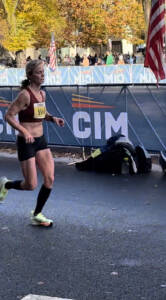
The CIM marathon finish line has two sides, an A and a B. Marathoners with “A” on their bibs will finish as they round the corner to the left side of the street. Marathoners with “B” will finish to the right of the street.
Crowds line the yards leading to the finish. The announcer announces most names of people who cross the finish line. There are bleachers for spectators to sit in on either side to get a clear view (and video!) of you crossing the line.
Unlike most major marathons (and CIM is the seventh-largest marathon in the U.S.), the finish isn’t chaotic. You finish with the California Capitol building in the background. Family can easily approach you as you walk from the finish line.
Volunteers hand you a medal, throwaway jacket, and bag. There are bananas, water, Nuun, and a beer tent. You can take your picture near a giant 26.2 mile sign with the Capitol in the background or ringing the “BQ bell.”
CIM Spectator Information:
Just as CIM is a well-oiled machine supporting runners, it is a well-oiled machine supporting spectators. The website lists road closures and best places to spectate. It even partnered with Waze so you can get driving directions to your watch spot.
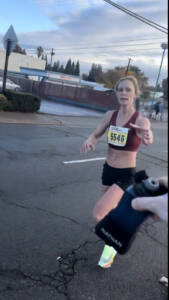
Being a spectator can be hard—with road closures and inaccurate tracking apps. CIM makes it so easy to catch your runner.
My husband saw me at the half-marathon mark with a bottle in hand. He easily parked at the Safeway and got to the course in plenty of time to support me.
At the finish, most parking garages were full but there was still on-street parking just blocks from the finish line.
Spectators need to pass through security so don’t have anything like a pocketknife with you, or you cannot pass through.
There are bleachers set up so you can easily spot your runner and an easy meeting spot over by the BQ bell and photo opportunity located at the base of the Capital steps.
CIM Marathon Bottomline:
Would I recommend you run this race? Heck yeah, I would. Even though I didn’t have my day on the CIM course, so many people do. If you want to set yourself for marathon success, CIM could be your ticket.
If you want guidance with your running or marathon goals, check out my run coaching services. Have you run CIM?


